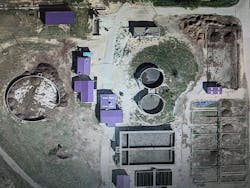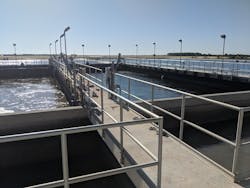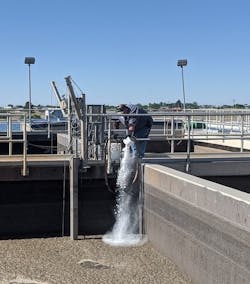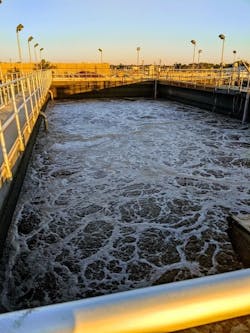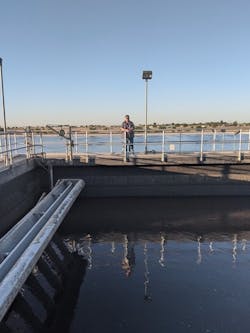About the author:
Chris Barricks is a freelance copywriter. Barricks can be reached at [email protected].
Ask Miguel De La Cruz the biggest challenge he faces as superintendent of the Wastewater Treatment Plant in Lovington, New Mexico, and he will jokingly say it is the park across the street.
“The city built a park directly across the street from the plant, so I hear about the odor from our compost heap now and then,” he said with a chuckle. “But I always tell them … ‘Hey, who was here first?’”
De La Cruz is happy to report that is his biggest challenge at the 2.5 million gallon per day (mgd)-rated sequencing batch reactor (SBR) activated sludge plant these days. For years, the problems were much larger. In fact, the plant, which has a flow of about 1.3 mgd, was dangerously close to noncompliance with the state environmental department and the possibility of some very hefty fines.
“We were having some serious settling problems in our SBR tanks,” De La Cruz said, who along with the two SBR tanks, has two aerobic digesters and a Huber screw press used for sludge dewatering. “Our tanks were overloaded with solids, yet they were wasting mostly water. We’d made all kinds of adjustments to address the issue. We changed the aeration rates and mixing rates. We were trying to increase our wasting rates. What was happening was we were wasting nothing but water, no solids, because stuff would not settle out. Then one day out of the blue, this guy shows up with the answer.”
An Outsider Perspective
De La Cruz is referring to Dan Ward, CEO of BICI Chemicals. Ward dropped by the plant in 2009 on a routine sales call and asked if they had any issues he could help with. De La Cruz, who did not know Ward at the time, doubted that he could. After all, De La Cruz had been fighting the issue for years, and he knew what he was doing. He had been with the city of Lovington for 18 years and before that, he had worked for the city of Hobbs Wastewater for 21 years. He holds a NM Wastewater IV, NM Water III, a NM Compost Facility Operator’s Certification and an AAS degree in Wastewater Technology from California State University Sacramento and New Mexico Junior College.
Ward, however, did something he had never seen before.
“Dan was the first salesman who ever showed up and instead of just talking about it, actually proved to us on the spot that his products would work,” De La Cruz said.
Ward recommended a combination of AT-318 and Aqua Aide. He told De La Cruz that AT-318 was the only 100% natural polymer replacement that will floc and floc an unlimited number of times. He noted how it could also be put in the mixed liquor, has an indefinite shelf life and how it had passed biomonitoring at 500 milligrams per liter and was completely safe. He went on about how it reduces phosphorus, controls filamentous bacteria bulking, dewaters sludge and much more. It all sounded too good to be true. So Ward, who has more than 50 years of industry experience, asked for two settleometer jars.
“He asked us to go get two jars of sludge from one of the SBRs,” De La Cruz said. “He put AT-318 and Aqua Aide in one of them and told us to watch. It was amazing. We sat there and watched it settle.”
The Test Became The Procedure
Ward used 1 gram of AT-318 and two drops of Aqua Aide for the test, but the results were far larger. In fact, De La Cruz was ready to try it in the SBRs. They performed microscopic tests and found out that the plant was overrun with filamentous bacteria and nocardia. The facility also had high levels of FOG. The mixed liquor suspended solid (MLSS) in the SBRs was running greater than 6,000 mg/L, but the plant needed to be at 2,500 mg/L.
Ward noted the safety of the products meant that users literally could not overuse them. So to jump start the process, BICI Chemicals applied a shock load of AT-318 and Aqua Aide.
“We put in 500 pounds of AT-318 and 55 gallons of Aqua Aide that first treatment,” De La Cruz said. “We started seeing a change in the solids within hours.”
Afterward, the city started daily dosing with AT-318 and Aqua Aide. Within a couple of days, the solids were settling and the waste flow to the digesters from the SBRs had thickened. Before AT-318 and Aqua Adie, the plant had approximately 0.5% solids. After treatment, however, the crew was reporting 2% solids.
De La Cruz, who is assisted by five operators and one lab tech, proved to his crew the safety of the all-natural AT-318 by actually tasting it. He justified the purchase of the products to the city by showing the savings he could get by reducing the purchase of polymer used to dewater the sludge. Now, more than 10 years later, he is still delivering on his promises.
Continued Positive Results
Since AT-318 and Aqua Aide were introduced into Lovington’s treatment plant, FOG and filamentous bacteria have become almost non-existent. The solids settle extremely well in the SBRs, and as a result of increased thickening in the solids in the digesters, Lovington plant workers have also noticed a decrease of about 25% in polymer usage in the screw press. These safe, reliable results give city leaders and De La Cruz’s crew peace of mind.
“AT-318 and Aqua Aide are unlike any products I’ve ever seen,” De La Cruz said. “The combination of these two keeps on working after it is activated so you don’t have to keep adding again and again. If you’re having settling problems in your SBR, more than likely you’re going to be having settling problems throughout the rest of the plant also. With this combo, you put it in one place and it continues to work until you get rid of it; until it’s completely wasted out. It does not lose its effectiveness after it is introduced into our SBRs. After wasting, it continues to work in our digesters. Our plant actually had to reduce the daily dosing to only four days a week. The solids in our digester were thickening so much, that our screw press was having trouble pumping them for dewatering.”
While AT-318 and Aqua Aide have certainly simplified things, De La Cruz is not on cruise-control when it comes to managing the plant. After all, he and his crew (which has more than 40 years of experience in its own right; Barry Ferguson, lab tech, 34 years; Alberto Lopez, 1.5 years; Giovanni Ornelas, 1 year; Noel Mundy, 5 years; Anthony Brown, 3 months; and Matthew McGee, 3 months) are watching over a system that includes the plant and approximately 73 miles of sewer line and 23 lift stations. There are plenty of things to worry about. Now, however, settling issues are not one of them. But what about odor issues at the park?
“If someone brings it up, I just tell them ‘This isn’t a perfume factory,’” De La Cruz said.
